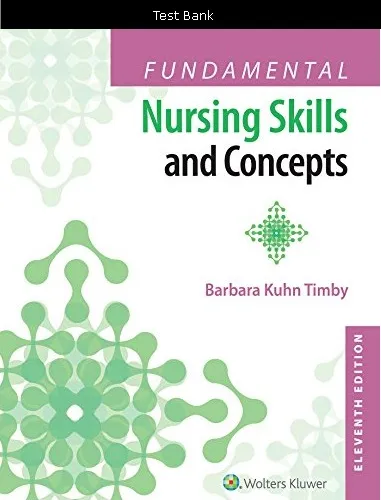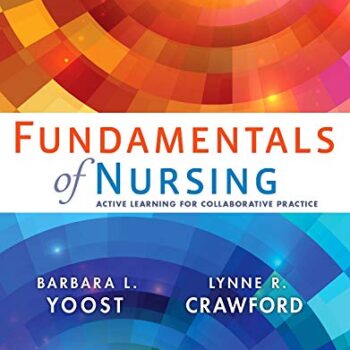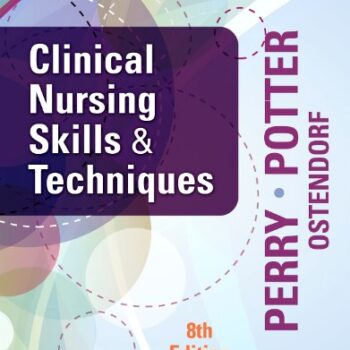In Stock
Fundamental Nursing Skills and Concepts 11th Edition Timby Test Bank
$55.00 Original price was: $55.00.$18.50Current price is: $18.50.
Digital item No Waiting Time Instant Download
Chapters: 38
Format: PDF
ISBN-13:978-1496327628
ISBN-10: 1496327624
Publisher: LWW
Authors: Barbara Kuhn Timby
SKU: 000786000589
Category: NURSING FUNDAMENTALS & SKILLS
Description
Fundamental Nursing Skills and Concepts 11th Edition Timby Test Bank
Table of Contents
Chapter 1. Nursing Foundations
Chapter 2. Nursing Process
Chapter 3. Laws and Ethics
Chapter 4. Health and Illness
Chapter 5. Homeostasis, Adaptation, and Stress
Chapter 6. Culture and Ethnicity
Chapter 7. The Nurse–Client Relationship
Chapter 8. Client Teaching
Chapter 9. Recording and Reporting
Chapter 10. Admission, Discharge, Transfer, and Referrals
Chapter 11. Vital Signs
Chapter 12. Physical Assessment
Chapter 13. Special Examinations and Tests
Chapter 14. Nutrition
Chapter 15. Fluid and Chemical Balance
Chapter 16. Hygiene
Chapter 17. Comfort, Rest, and Sleep
Chapter 18. Safety
Chapter 19. Pain Management
Chapter 20. Oxygenation
Chapter 21. Asepsis
Chapter 22. Infection Control
Chapter 23. Body Mechanics, Positioning, and Moving
Chapter 24. Therapeutic Exercise
Chapter 25. Mechanical Immobilization
Chapter 26. Ambulatory Aids
Chapter 27. Perioperative Care
Chapter 28. Wound Care
Chapter 29. Gastrointestinal Intubation
Chapter 20. Urinary Elimination
Chapter 31. Bowel Elimination
Chapter 32. Oral Medications
Chapter 33. Topical and Inhalant Medications
Chapter 34. Parenteral Medications
Chapter 35. Intravenous Medications
Chapter 36. Airway Management
Chapter 37. Resuscitation
Chapter 38. Death and Dying
Fundamental Nursing Skills and Concepts 11th Edition Timby Test Bank
Chapter 1 Nursing Foundations
MULTIPLE CHOICE
1. Florence Nightingales contributions to nursing practice and education:
a. are historically important but have no validity for nursing today.
b. were neither recognized nor appreciated in her own time.
c. were a major factor in reducing the death rate in the Crimean War.
d. were limited only to the care of severe traumatic wounds.
ANS: C
By improving sanitation, nutrition ventilation, and handwashing techniques, Florence
Nightingales nurses dramatically reduced the death rate from injuries in the Crimean War.
DIF: Cognitive Level: Knowledge REF: dm 2 OBJ: Theory #1
TOP: Nursing History KEY: Nursing Process Step: N/A
MSC: NCLEX: N/A
2. Early nursing education and care in the United States:
a. were directed at community health.
b. provided independence for women through education and employment.
c. were an educational model based in institutions of higher learning.
d. have continued to be entirely focused on hospital nursing.
ANS: B
Because of the influence of early nursing leaders, nursing education became more formalized
through apprenticeships in Nightingale schools that offered independence to women through
education and employment.
DIF: Cognitive Level: Knowledge REF: dm 2 OBJ: Theory #4
TOP: Nursing History KEY: Nursing Process Step: N/A
MSC: NCLEX: N/A
3. In order to fulfill the common goals defined by nursing theorists (promote wellness, prevent
illness, facilitate coping, and restore health), the LPN must take on the roles of:
a. caregiver, educator, and collaborator.
b. nursing assistant, delegator, and environmental specialist.
c. medication dispenser, collaborator, and transporter.
d. dietitian, manager, and housekeeper.
ANS: A
In order for the LPN to apply the common goals of nursing, he or she must assume the roles of
caregiver, educator, collaborator, manager, and advocate.
DIF: Cognitive Level: Comprehension REF: dm 4 OBJ: Theory #2
TOP: Art and Science of Nursing KEY: Nursing Process Step: N/A
MSC: NCLEX: N/A
www.prepthenurse.com prepthenurse.com
4. Although nursing theories differ in their attempts to define nursing, all of them base their
beliefs on common concepts concerning:
a. self-actualization, fundamental needs, and belonging.
b. stress reduction, self-care, and a systems model.
c. curative care, restorative care, and terminal care.
d. human relationships, the environment, and health.
ANS: D
Although nursing theories differ, they all base their beliefs on human relationships, the
environment, and health.
DIF: Cognitive Level: Comprehension REF: dm 4 OBJ: Theory #2
TOP: Nursing Theories KEY: Nursing Process Step: N/A
MSC: NCLEX: N/A
5. Standards of care for the nursing practice of the LPN are established by the:
a. Boards of Nursing Examiners in each state.
b. National Council of States Boards of Nursing (NCSBN).
c. American Nurses Association (ANA).
d. National Federation of Licensed Practical Nurses.
ANS: D
The National Federation of Licensed Practical Nurses modified the standards published by the
ANA in 2004 to better fit the role of the LPN.
DIF: Cognitive Level: Comprehension REF: dm 5 OBJ: Theory #2
TOP: Standards of Care KEY: Nursing Process Step: N/A
MSC: NCLEX: N/A
6. The LPN demonstrates an evidence-based practice by:
a. using a drug manual to check compatibility of drugs.
b. using scientific information to guide decision making.
c. using medical history of a patient to direct nursing interventions.
d. basing nursing care on advice from an experienced nurse.
ANS: B
The use of scientific information from high-quality research to guide nursing decisions is
reflective of the application of evidence-based practice.
DIF: Cognitive Level: Knowledge REF: dm 5 OBJ: Theory #3
TOP: Evidence Based Practice KEY: Nursing Process Step: N/A
MSC: NCLEX: N/A
7. Lillian Wald and Mary Brewster established the Henry Street Settlement Service in New York
in 1893 in order to:
a. offer a shelter to injured war veterans.
b. found a nursing apprenticeship.
c. provide health care to poor persons living in tenements.
d. offer better housing to low-income families.
www.prepthenurse.com prepthenurse.com
ANS: C
Henry Street Settlement Service brought the provision of community health care to the poor
people living in tenements.
DIF: Cognitive Level: Comprehension REF: dm 2 OBJ: Theory #4
TOP: Growth of Nursing KEY: Nursing Process Step: N/A
MSC: NCLEX: N/A
8. An educational pathway for an LPN refers to an LPN:
a. learning on the job and being promoted to a higher level of responsibility.
b. moving from a maternity unit to a more complicated surgical unit.
c. obtaining additional education to move from one level of nursing to another.
d. learning that advancement requires consistent work and commitment.
ANS: C
By broadening the educational base, an LPN may advance and build a nursing career.
DIF: Cognitive Level: Knowledge REF: dm 6 OBJ: Theory #7
TOP: Nursing Education Pathways KEY: Nursing Process Step: N/A
MSC: NCLEX: N/A
9. When diagnosis-related groups (DRGs) were established by Medicare in 1983, the purpose
was to:
a. put patients with the same diagnosis on the same unit.
b. attempt to contain the costs of health care.
c. increase availability of medical care to the elderly.
d. identify a patients condition more quickly.
ANS: B
The purpose of instituting DRGs was to contain skyrocketing costs of health care.
DIF: Cognitive Level: Knowledge REF: dm 8 OBJ: Theory #10
TOP: Health Care Delivery KEY: Nursing Process Step: N/A
MSC: NCLEX: N/A
10. The advent of diagnosis-related groups (DRGs) required that nurses working in health care
agencies:
a. record supportive documentation to confirm a patients need for care in order to qualify for reimbursb. use the DRG rather than their own observations for patient assessment.
c. be aware of the specific drugs related to the diagnosis.
d. acquire cross-training to make staffing more flexible.
ANS: A
DRGs required that nurses provide more supportive documentation of their assessments and
identified patient needs to qualify the facility for Medicare reimbursement. Observant assessment
might also indicate another DRG classification and consequently more reimbursement for the
facility.
DIF: Cognitive Level: Comprehension REF: dm 8 OBJ: Theory #10
TOP: Managed Care KEY: Nursing Process Step: N/A
MSC: NCLEX: N/A
MULTIPLE CHOICE
1. Florence Nightingales contributions to nursing practice and education:
a. are historically important but have no validity for nursing today.
b. were neither recognized nor appreciated in her own time.
c. were a major factor in reducing the death rate in the Crimean War.
d. were limited only to the care of severe traumatic wounds.
ANS: C
By improving sanitation, nutrition ventilation, and handwashing techniques, Florence
Nightingales nurses dramatically reduced the death rate from injuries in the Crimean War.
DIF: Cognitive Level: Knowledge REF: dm 2 OBJ: Theory #1
TOP: Nursing History KEY: Nursing Process Step: N/A
MSC: NCLEX: N/A
2. Early nursing education and care in the United States:
a. were directed at community health.
b. provided independence for women through education and employment.
c. were an educational model based in institutions of higher learning.
d. have continued to be entirely focused on hospital nursing.
ANS: B
Because of the influence of early nursing leaders, nursing education became more formalized
through apprenticeships in Nightingale schools that offered independence to women through
education and employment.
DIF: Cognitive Level: Knowledge REF: dm 2 OBJ: Theory #4
TOP: Nursing History KEY: Nursing Process Step: N/A
MSC: NCLEX: N/A
3. In order to fulfill the common goals defined by nursing theorists (promote wellness, prevent
illness, facilitate coping, and restore health), the LPN must take on the roles of:
a. caregiver, educator, and collaborator.
b. nursing assistant, delegator, and environmental specialist.
c. medication dispenser, collaborator, and transporter.
d. dietitian, manager, and housekeeper.
ANS: A
In order for the LPN to apply the common goals of nursing, he or she must assume the roles of
caregiver, educator, collaborator, manager, and advocate.
DIF: Cognitive Level: Comprehension REF: dm 4 OBJ: Theory #2
TOP: Art and Science of Nursing KEY: Nursing Process Step: N/A
MSC: NCLEX: N/A
www.prepthenurse.com prepthenurse.com
4. Although nursing theories differ in their attempts to define nursing, all of them base their
beliefs on common concepts concerning:
a. self-actualization, fundamental needs, and belonging.
b. stress reduction, self-care, and a systems model.
c. curative care, restorative care, and terminal care.
d. human relationships, the environment, and health.
ANS: D
Although nursing theories differ, they all base their beliefs on human relationships, the
environment, and health.
DIF: Cognitive Level: Comprehension REF: dm 4 OBJ: Theory #2
TOP: Nursing Theories KEY: Nursing Process Step: N/A
MSC: NCLEX: N/A
5. Standards of care for the nursing practice of the LPN are established by the:
a. Boards of Nursing Examiners in each state.
b. National Council of States Boards of Nursing (NCSBN).
c. American Nurses Association (ANA).
d. National Federation of Licensed Practical Nurses.
ANS: D
The National Federation of Licensed Practical Nurses modified the standards published by the
ANA in 2004 to better fit the role of the LPN.
DIF: Cognitive Level: Comprehension REF: dm 5 OBJ: Theory #2
TOP: Standards of Care KEY: Nursing Process Step: N/A
MSC: NCLEX: N/A
6. The LPN demonstrates an evidence-based practice by:
a. using a drug manual to check compatibility of drugs.
b. using scientific information to guide decision making.
c. using medical history of a patient to direct nursing interventions.
d. basing nursing care on advice from an experienced nurse.
ANS: B
The use of scientific information from high-quality research to guide nursing decisions is
reflective of the application of evidence-based practice.
DIF: Cognitive Level: Knowledge REF: dm 5 OBJ: Theory #3
TOP: Evidence Based Practice KEY: Nursing Process Step: N/A
MSC: NCLEX: N/A
7. Lillian Wald and Mary Brewster established the Henry Street Settlement Service in New York
in 1893 in order to:
a. offer a shelter to injured war veterans.
b. found a nursing apprenticeship.
c. provide health care to poor persons living in tenements.
d. offer better housing to low-income families.
www.prepthenurse.com prepthenurse.com
ANS: C
Henry Street Settlement Service brought the provision of community health care to the poor
people living in tenements.
DIF: Cognitive Level: Comprehension REF: dm 2 OBJ: Theory #4
TOP: Growth of Nursing KEY: Nursing Process Step: N/A
MSC: NCLEX: N/A
8. An educational pathway for an LPN refers to an LPN:
a. learning on the job and being promoted to a higher level of responsibility.
b. moving from a maternity unit to a more complicated surgical unit.
c. obtaining additional education to move from one level of nursing to another.
d. learning that advancement requires consistent work and commitment.
ANS: C
By broadening the educational base, an LPN may advance and build a nursing career.
DIF: Cognitive Level: Knowledge REF: dm 6 OBJ: Theory #7
TOP: Nursing Education Pathways KEY: Nursing Process Step: N/A
MSC: NCLEX: N/A
9. When diagnosis-related groups (DRGs) were established by Medicare in 1983, the purpose
was to:
a. put patients with the same diagnosis on the same unit.
b. attempt to contain the costs of health care.
c. increase availability of medical care to the elderly.
d. identify a patients condition more quickly.
ANS: B
The purpose of instituting DRGs was to contain skyrocketing costs of health care.
DIF: Cognitive Level: Knowledge REF: dm 8 OBJ: Theory #10
TOP: Health Care Delivery KEY: Nursing Process Step: N/A
MSC: NCLEX: N/A
10. The advent of diagnosis-related groups (DRGs) required that nurses working in health care
agencies:
a. record supportive documentation to confirm a patients need for care in order to qualify for reimbursb. use the DRG rather than their own observations for patient assessment.
c. be aware of the specific drugs related to the diagnosis.
d. acquire cross-training to make staffing more flexible.
ANS: A
DRGs required that nurses provide more supportive documentation of their assessments and
identified patient needs to qualify the facility for Medicare reimbursement. Observant assessment
might also indicate another DRG classification and consequently more reimbursement for the
facility.
DIF: Cognitive Level: Comprehension REF: dm 8 OBJ: Theory #10
TOP: Managed Care KEY: Nursing Process Step: N/A
MSC: NCLEX: N/A





Be the first to review “Fundamental Nursing Skills and Concepts 11th Edition Timby Test Bank”